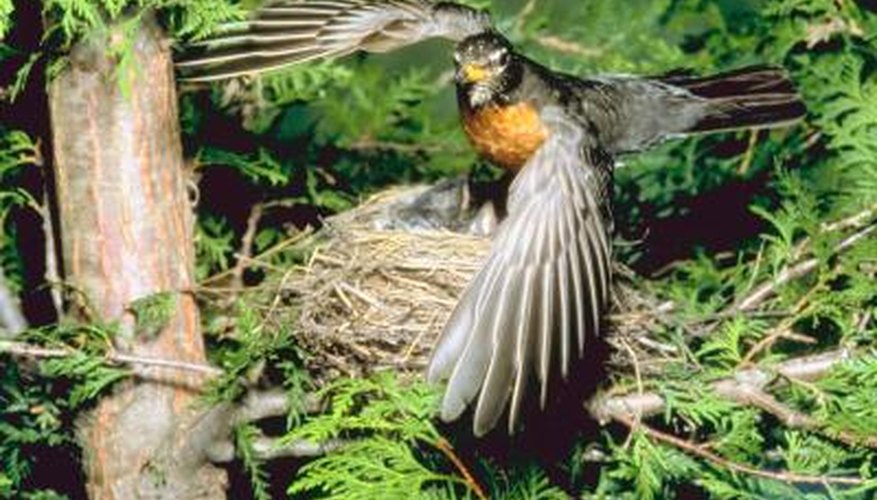English starlings were brought to New York in the early 1890s and are now densely distributed throughout the United States. They are extremely social, and their winter flocks can contain thousands of birds. The larger American robin is also very common in the United States and is known as the "harbinger of spring." Many robins actually winter in their usual breeding range but frequently roost in trees during the cold weather. Robins and starlings have distinctly different nesting, egg laying and incubation behaviours.
Nest Locations
Starlings are cavity-dwelling birds that nest in holes in trees or anywhere there is an opening in a building. They frequently build nests near parks, meadows or woodlands. Robin females usually choose nesting sites on the lower branches of a tree just below a thick layer of leaves. They will sometimes select a thicket, gutter, eaves or light fixture for a nest site.
- Starlings are cavity-dwelling birds that nest in holes in trees or anywhere there is an opening in a building.
- Robin females usually choose nesting sites on the lower branches of a tree just below a thick layer of leaves.
Nest Building
Starlings construct their nests mostly of twigs, grass, cloth, rootlets and pine needles, often lining them for the eggs with feathers, moss and fresh leaves. The male begins the nest, and the female will rearrange and change his work to suit her preferences. Female robins will build neat, cup-shaped nests of materials, such as paper, rootlets, grass, twigs and mud, and make a cushion for the eggs of fine, dry grass. They construct their nests from the inside out. Ordinarily, both starlings and robins take one to three days to build their nests.
- Starlings construct their nests mostly of twigs, grass, cloth, rootlets and pine needles, often lining them for the eggs with feathers, moss and fresh leaves.
- Female robins will build neat, cup-shaped nests of materials, such as paper, rootlets, grass, twigs and mud, and make a cushion for the eggs of fine, dry grass.
Egg Variations and Laying
Starling eggs are somewhat glossy and pale greenish or bluish white, while robin eggs are unmarked blue-green or sky blue. Female starlings ordinarily lay one egg per day, as do robins. Robins lay their eggs much later in the morning than most other birds. The female robin eats large quantities of worms before she lays her eggs. Starlings generally lay eggs earlier in the morning and eat their usual diet of insects, seeds, snails and spiders at short intervals after laying the eggs.
- Starling eggs are somewhat glossy and pale greenish or bluish white, while robin eggs are unmarked blue-green or sky blue.
- Robins lay their eggs much later in the morning than most other birds.
Incubation and Hatching
Male and female starlings incubate their eggs for 12 days. During incubation and when eggs begin to hatch, starlings will add new green plant pieces to the nest. Starlings return to nest sites in the same breeding season if their original clutch fails because of predation or bad weather. Mother robins let eggs in the nest cool for short periods of time until they have a full clutch so babies won't hatch too far apart. They ordinarily sit on their nest eggs for 12 to 14 days and only leave them for short intervals. Males will also occasionally sit on the eggs. Robins often have up to three broods in the same season.
- Male and female starlings incubate their eggs for 12 days.
- They ordinarily sit on their nest eggs for 12 to 14 days and only leave them for short intervals.
